Have you ever stood in your kitchen, holding a bottle of your favorite vintage, wondering where to store it properly? That moment when you realize your wine deserves better than a cramped cabinet or the uncertainty of room temperature storage? You’re not alone in this feeling. Creating a dedicated wine cellar space isn’t just about storage—it’s about honoring the craftsmanship behind every bottle and creating moments of joy in your daily life.
The beauty of wine lies not just in its taste, but in the ritual of preservation and the anticipation of the perfect moment to uncork. Whether you’re unwinding after a challenging day or welcoming friends for an intimate gathering, having your own home wine cellar transforms ordinary moments into extraordinary experiences. Wine, crafted through the careful fermentation of grapes, becomes more than a beverage—it becomes a bridge to connection, celebration, and personal satisfaction.
Understanding Wine Storage Types: Your Foundation for Success
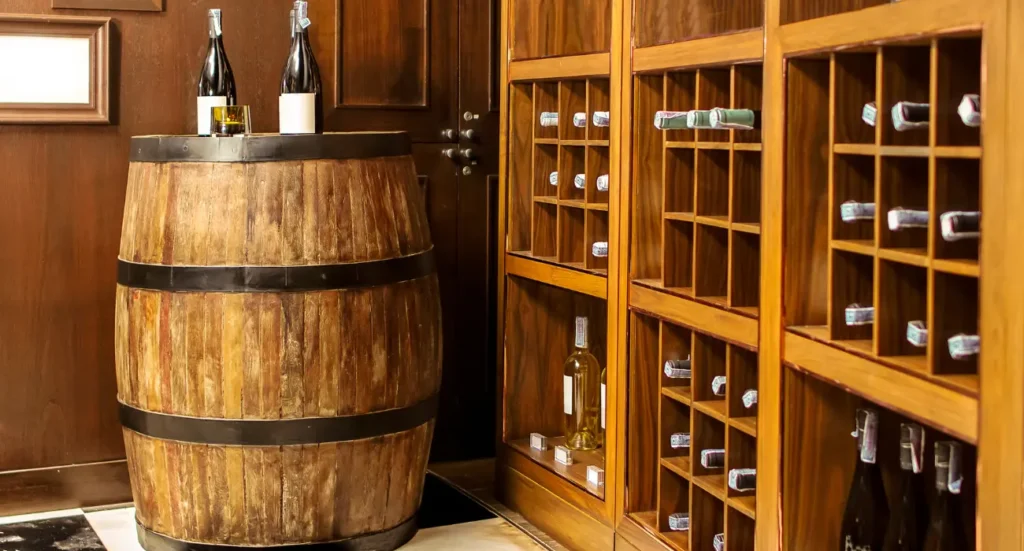
Before diving into your wine cellar project, understanding the different storage options available will help you make the best decision for your space, budget, and collection size. Each type offers unique benefits and considerations that align with different lifestyles and preferences.
Passive Wine Storage: The Traditional Approach
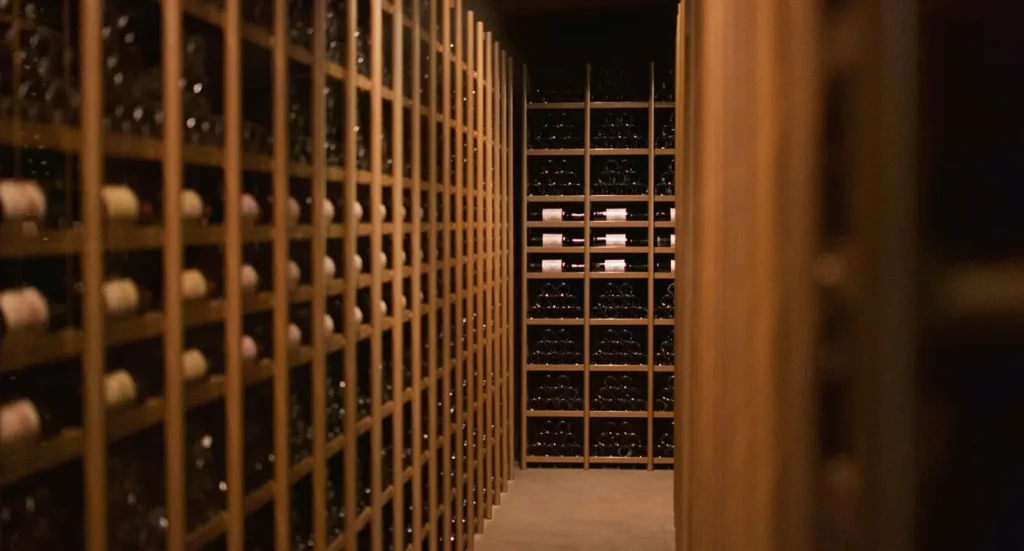
A passive wine cellar operates without electrical climate control systems, relying instead on natural environmental factors to maintain proper storage conditions. This approach mirrors traditional wine storage methods used for centuries in underground cellars and caves.
The success of passive storage depends heavily on location selection and structural considerations. Underground spaces, thick walls, and areas with minimal temperature fluctuation create ideal conditions. These cellars work best in basements or interior rooms where external temperature variations have minimal impact.
Key advantages include lower operating costs, complete silence, and no dependence on electrical systems. However, they require careful planning and may not be suitable for all climates or home configurations.
Thermoelectric Wine Cellars: Modern Efficiency Meets Quiet Operation
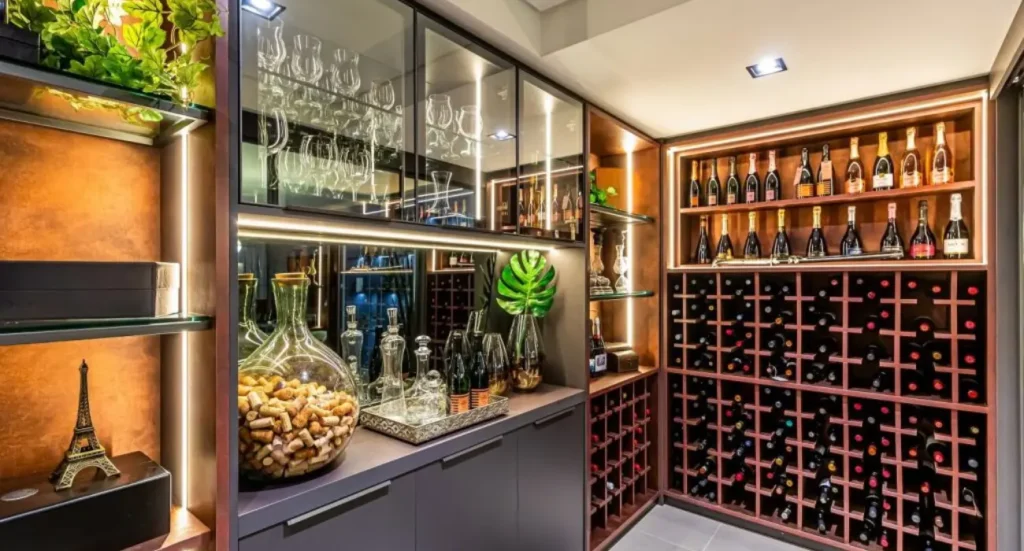
Thermoelectric wine coolers represent the middle ground between passive storage and high-tech solutions. These units use ceramic plates to absorb heat from the interior and transfer it outside, maintaining consistent temperatures without traditional refrigeration components.
The technology behind thermoelectric cooling eliminates vibrations and operates virtually silently, making these units perfect for living spaces where noise could be disruptive. They’re available in various sizes, from compact 4-bottle units to larger installations holding 50 or more bottles.
These systems excel in moderate climates and controlled indoor environments. They consume less energy than compressor units and offer precise temperature control, making them ideal for serious collectors who prioritize wine preservation.
Compressor Wine Refrigerators: Maximum Control and Capacity
Compressor-based wine refrigeration systems function similarly to household refrigerators, using refrigerant to actively cool the storage space. These units inject cold air throughout the compartment, maintaining consistent temperatures even in challenging environmental conditions.
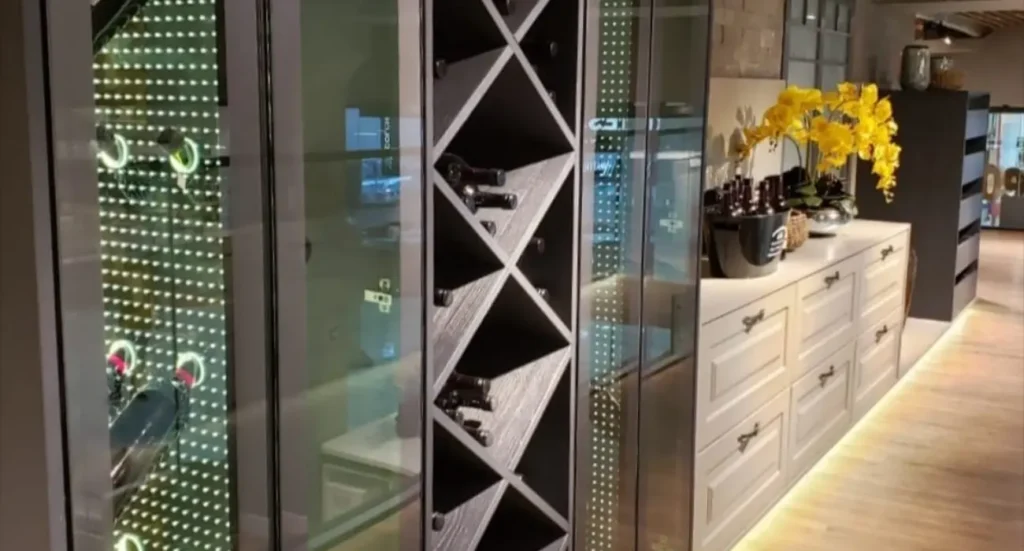
The robust cooling capacity makes compressor units suitable for larger collections and warmer climates. They can maintain proper storage temperatures regardless of external conditions, offering maximum flexibility in placement and reliability in performance.
While these units generate more noise and consume more energy than thermoelectric alternatives, they provide unmatched cooling power and temperature stability for serious wine enthusiasts with extensive collections.
Strategic Wine Cellar Design: Choosing the Perfect Location
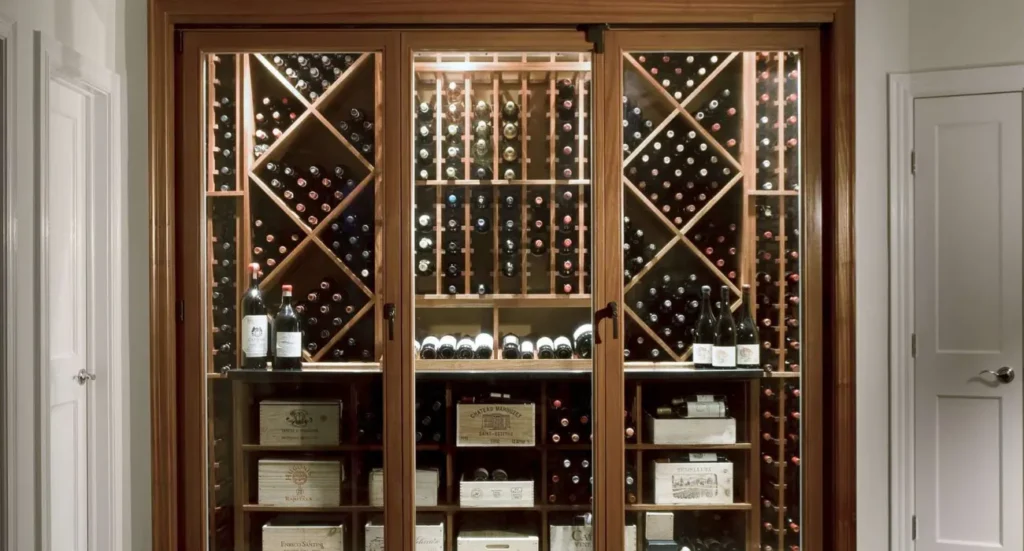
The location of your wine cellar fundamentally impacts both the preservation quality of your collection and your enjoyment of the space. Proper placement considers multiple factors that affect wine quality and accessibility.
Avoiding Light and Heat Exposure
Direct sunlight and heat sources represent the greatest threats to wine quality. UV rays break down wine compounds, while temperature fluctuations accelerate aging and can ruin delicate flavors. Choose locations away from windows, heating vents, and heat-generating appliances.
Interior spaces typically offer the most stable conditions. Basements provide natural temperature stability, while interior closets or dedicated rooms can work well with proper climate control. Even compact spaces can accommodate smaller wine storage solutions when properly planned.
Proximity to Social Areas

Wine cellar placement near entertaining spaces enhances both functionality and visual impact. Positioning your cellar near the kitchen, dining room, or living area makes wine selection convenient during meals and gatherings.
Consider the flow of your home when choosing locations. A wine cellar becomes a conversation piece when guests can admire your collection, but it should remain easily accessible for daily use. Open designs can showcase your collection while maintaining proper storage conditions.
Size Considerations and Capacity Planning
The available space determines your collection capacity and influences the type of storage system you can implement. Measure carefully and consider both current needs and future expansion plans.
Compact spaces work well with vertical storage solutions and wall-mounted units. Larger areas allow for walk-in cellars with multiple storage zones for different wine types. Remember that proper spacing between bottles ensures adequate air circulation and easy access.
Custom Wine Storage Solutions: Maximizing Your Space
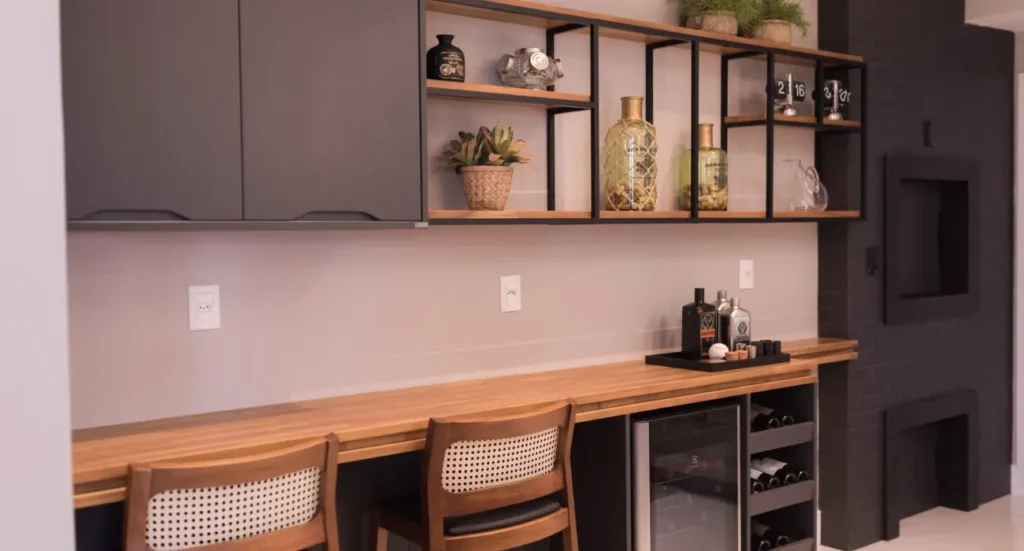
Custom-designed wine storage offers unlimited possibilities for creating the perfect cellar that matches your home’s aesthetic while meeting your functional needs. Planned wine furniture integrates seamlessly with existing décor while providing specialized storage features.
Integration with Home Décor
Your wine cellar should complement your home’s design style rather than appearing as an afterthought. Choose materials and finishes that harmonize with surrounding elements. Brushed stainless steel works beautifully in modern kitchens, while rich wood tones complement traditional or rustic décor.
Color coordination extends beyond the storage unit itself. Consider how wine bottles’ colors and labels contribute to the overall visual impact. Dark bottles create dramatic displays, while lighter wines add brightness to the design.
Specialized Storage Features
Custom installations can incorporate features that enhance both functionality and visual appeal. Consider built-in temperature controls, LED lighting systems, and humidity monitoring for optimal wine preservation.
Additional storage for wine accessories elevates the entire experience. Dedicated spaces for corkscrews, decanters, glasses, and serving accessories keep everything organized and easily accessible. Some designs include areas for wine journals, tasting notes, and reference materials.
Embedding Systems for Seamless Integration
Built-in wine storage systems create sophisticated looks while maximizing space efficiency. Climate-controlled units can be embedded into cabinetry, walls, or kitchen islands for a seamless appearance.
This approach allows you to combine wine storage with other functions. Kitchen islands can incorporate wine storage alongside food prep areas, while living room built-ins can display bottles alongside books and decorative items.
Professional Installation and Wine Cellar Maintenance
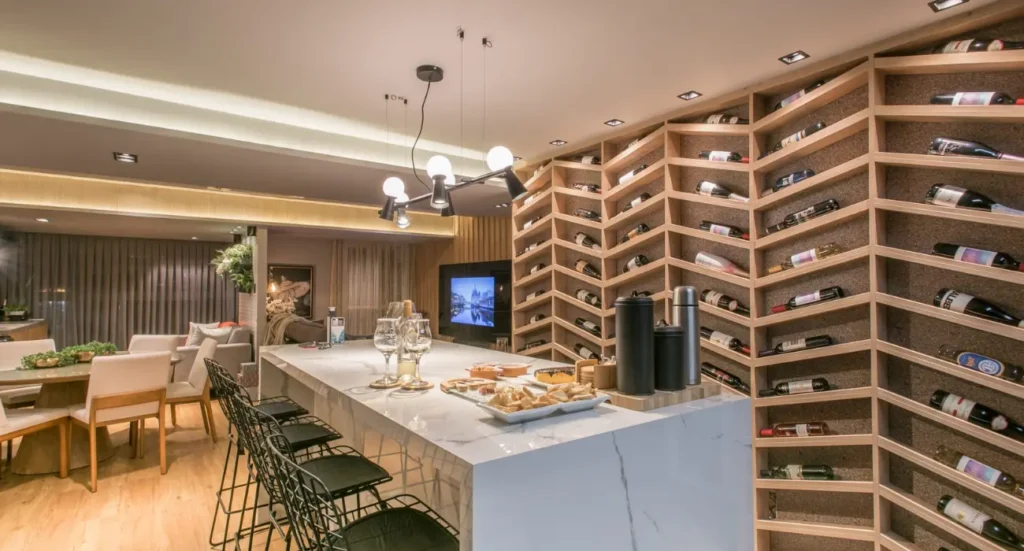
Proper installation ensures your wine cellar operates efficiently and preserves your collection effectively. Professional installation provides peace of mind and often includes warranty coverage for both equipment and workmanship.
Temperature and Humidity Control
Maintaining consistent temperatures between 45-65°F (7-18°C) with humidity levels around 60-70% creates optimal storage conditions. Professional installers understand the nuances of achieving these conditions in different home environments.
Monitoring systems track environmental conditions and alert you to any variations that could affect your wine. Some advanced systems connect to smartphone apps, allowing remote monitoring and control of your cellar conditions.
Ventilation and Air Circulation
Proper air circulation prevents stagnant conditions that can lead to mold or off-odors. Professional installations include ventilation systems that maintain air quality without disrupting temperature stability.
Consider the placement of intake and exhaust vents to ensure even air distribution throughout the storage space. Poor ventilation can create hot spots or areas of excessive humidity that damage wine labels and corks.
Wine Collection Storage Best Practices

Understanding proper storage techniques protects your investment and ensures wines develop as intended. These practices apply regardless of the storage system you choose.
Bottle Positioning and Organization
Store bottles horizontally to keep corks moist and prevent air infiltration. Consistent positioning also maximizes space efficiency and creates an organized appearance.
Organize wines by type, region, or vintage for easy selection. Consider rotation systems that place newer acquisitions in back while keeping ready-to-drink wines easily accessible. Some collectors prefer organization by drinking timeline, with everyday wines in the most accessible locations.
Inventory Management
Maintaining accurate records prevents overbuying and helps track wine development. Digital apps simplify inventory management and can include photos, tasting notes, and purchase information.
Regular inventory checks ensure you’re aware of wines approaching their optimal drinking windows. This practice helps you plan special occasions around peak drinking times and prevents wines from aging beyond their prime.
Creating the Perfect Wine Tasting Experience
Your wine cellar becomes more than storage—it becomes the foundation for memorable experiences. Consider how the space can enhance wine enjoyment and sharing with others.
Tasting Areas and Accessories
If space allows, incorporate a small tasting area near your wine storage. A compact counter or table provides space for opening bottles and brief tastings. Proper lighting helps evaluate wine color and clarity.
Essential accessories include quality glassware, decanters, and aerators. Store these items near your wine collection for convenience. Consider the storage needs for different glass types—red wine glasses, white wine glasses, and specialty glasses for sparkling wines or dessert wines.
Entertainment and Social Aspects
Design your wine cellar as a social space that encourages sharing and conversation. Even small installations can become focal points that spark discussions about wine, travel, and experiences.
Consider lighting that creates ambiance while maintaining proper storage conditions. LED systems offer flexibility in creating different moods while generating minimal heat that could affect wine storage.
Key Points to Remember
- Choose storage systems based on your collection size, budget, and available space
- Location selection significantly impacts wine preservation and accessibility
- Custom installations offer maximum flexibility and integration with home design
- Professional installation ensures optimal performance and longevity
- Proper organization and inventory management protect your investment
- Environmental controls maintain ideal temperature and humidity conditions
- Regular maintenance prevents problems and extends system life
Conclusion
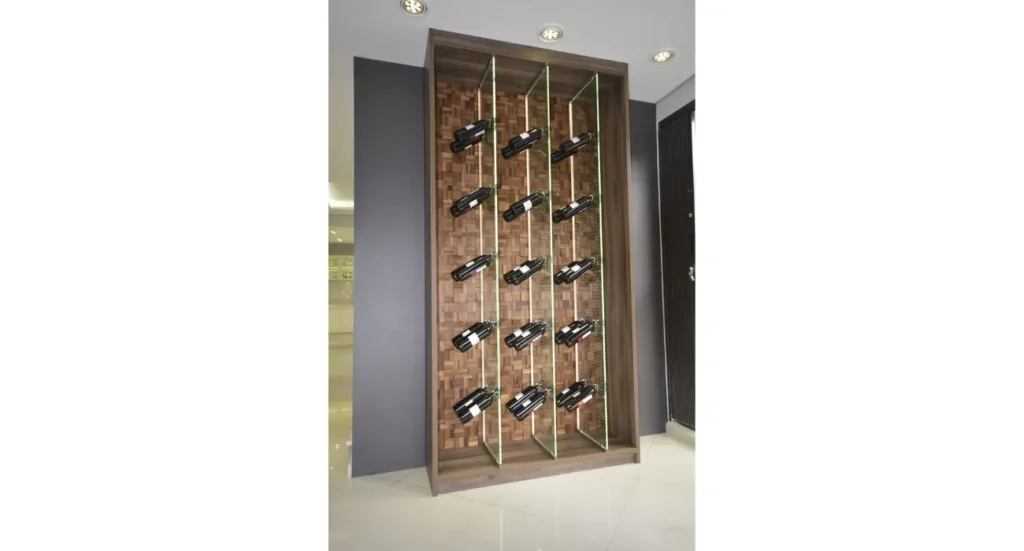
Building your dream wine cellar represents more than just creating storage space—it’s about crafting an environment that celebrates your passion for wine and enhances your lifestyle. Whether you choose a simple passive storage solution or invest in a sophisticated climate-controlled system, the key lies in matching your choice to your specific needs, space, and collection goals.
The journey from dreaming about a wine cellar to actually enjoying perfectly preserved wines in your own home doesn’t have to be overwhelming. Start with understanding your collection size, evaluate your available space, and choose the storage type that best fits your lifestyle. Remember that even small implementations can dramatically improve your wine storage and enjoyment.
As you embark on this exciting project, focus on creating a space that brings you joy every time you select a bottle. Your wine cellar will become a reflection of your taste, a conversation starter with guests, and a source of pride as you build and curate your collection over time. The investment in proper wine storage pays dividends in preservation quality, convenience, and the pure pleasure of knowing your wines are cared for properly.
Frequently Asked Questions
1. What’s the ideal temperature for storing wine at home?
The optimal temperature range for wine storage is between 45-65°F (7-18°C), with 55°F (13°C) being considered perfect for most wines. Consistency is more important than the exact temperature, as fluctuations can damage wine quality more than slightly warmer or cooler stable temperatures.
2. How much space do I need for a basic wine cellar setup?
You can create effective wine storage in surprisingly small spaces. Compact thermoelectric units require as little as 2 square feet of floor space and can hold 12-20 bottles. For larger collections, plan approximately 1 square foot per 10-15 bottles, including access space and future expansion.
Do I need professional installation for wine cellar equipment?
3. Do I need professional installation for wine cellar equipment?
While smaller countertop units can be self-installed, built-in systems and larger installations benefit from professional installation. Professional installers ensure proper ventilation, electrical connections, and optimal performance. They also provide warranty coverage and ongoing support for your investment.

